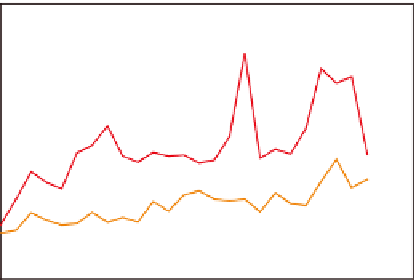Biomedical Engineering Reference
In-Depth Information
10
12:6 interaction potential
8
φ
= 0.20
6
T
*
4
0.3
0.5
2
0.7
0
0.9
0
10
20
30
40 50
t
(
a
2
/
D
0
)
60
70
80
Time dependence of G
eq
for the 12:6 interaction potential with
ϕ
= 0.2 and for a series of
temperatures. A transition appears between temperatures T
*
= 0.5 and 0.7, which suggests the
formation of a network, and determines the gel line in
Figure 2.19
. From Lodge and Heyes (
1999a
),
reproduced with permission of the American Institute of Physics for The Society of Rheology.
Figure 2.23
For the higher volume fractions, which form fairly large dense clusters, the magnitude of
G
eq
eventually increases to a similar value for all volume fractions.
2.6.3
Improvements of the interaction potentials
In more recent work Del Gado and Kob (
2005
,
2007
,
2008
) investigated the role of
directionally effective interactions in the formation of colloidal gels at very low volume
fractions. These interactions could account for the low coordination numbers and the
local rigidity reported in experimental studies. For the
first time, the use of more
-
-
complicated interactions allowed formation of open
structures
that are also stable at relatively high temperatures and low volume fractions; this is
de
i.e. rami
ed and fractal
nite progress compared with previous models. In particular, the case of a relatively
simple network structure, with chains connected by bridging points, was studied, allow-
ing analysis of the role of the various parts of the structure in the dynamics.
Using molecular dynamics simulations, Del Gado and Kob (
2008
)introducedan
effective potential that is the sum of two- and three-body terms. The two-body potential
is itself the sum of a generalized LJ 18:16 potential and a term that depends on the relative
orientation of the particles. This new approach gives a more realistic view of the interaction
potentials for colloids that are seldom uniform and smooth. Then, when they come into
contact, their
could produce rigid links between particles. Accordingly, each
particle was decorated with 12 points in such a way that interactions became more
favourable when the centre of the particles was aligned preferentially in the direction of
the points. In addition, an explicit short-range, three-body interaction was included. Such a
potential introduces a mechanism that favours the formation of an open network relative to
phase separation induced by purely radial interactions. As a consequence, there is an
'
roughness
'


































































Search WWH ::

Custom Search